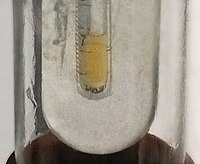
Photo from wikipedia
Metal ion release studies were carried out on three of the most commonly used orthodontic wires in the clinic: austenitic stainless steel, Ti-Mo, and superelastic NiTi, using three mouthwashes with… Click to show full abstract
Metal ion release studies were carried out on three of the most commonly used orthodontic wires in the clinic: austenitic stainless steel, Ti-Mo, and superelastic NiTi, using three mouthwashes with different fluoride concentrations: 130, 200, and 380 ppm. Immersions were carried out in these mouthwashes at 37 °C for 1, 4, 7, and 14 days, and the ions released were determined by inductively coupled plasma-mass spectrometry (ICP-MS). All wires were observed by scanning electron microscopy (SEM). The results showed a moderate ion release in the stainless steel wires, with nickel and chromium values of 500 and 1000 ppb in the worst conditions for the wires: concentrations of 380 ppm fluoride and 14 days of immersion. However, in the Ti-Mo and NiTi alloys, an abrupt change in release was observed when the samples were immersed in 380 ppm fluoride concentrations. Titanium releases in Ti-Mo wires reached 200,000 ppb, creating numerous pits on the surface. Under the same conditions, the release of Ni and Ti ions from the superelastic wires also exceeded 220,000 ppb and 180,000 ppb, respectively. This release of ions causes variations in the chemical composition of the wires, causing the appearance of martensite plates in the austenitic matrix after 4 days of immersion. This fact causes it to lose its superelastic properties at a temperature of 37 °C. In the case of immersion in 380 ppm mouthwashes for more than 7 days, rich-nickel precipitates can be seen. These embrittle the wire and lose all tooth-correcting properties. It should be noted that the release of Ni ions can cause hypersensitivity in patients, particularly women. The results indicate that the use of mouthwashes with a high content of fluoride should not be recommended with orthodontic archwires.
Journal Title: International Journal of Environmental Research and Public Health
Year Published: 2023
Link to full text (if available)
Share on Social Media: Sign Up to like & get
recommendations!